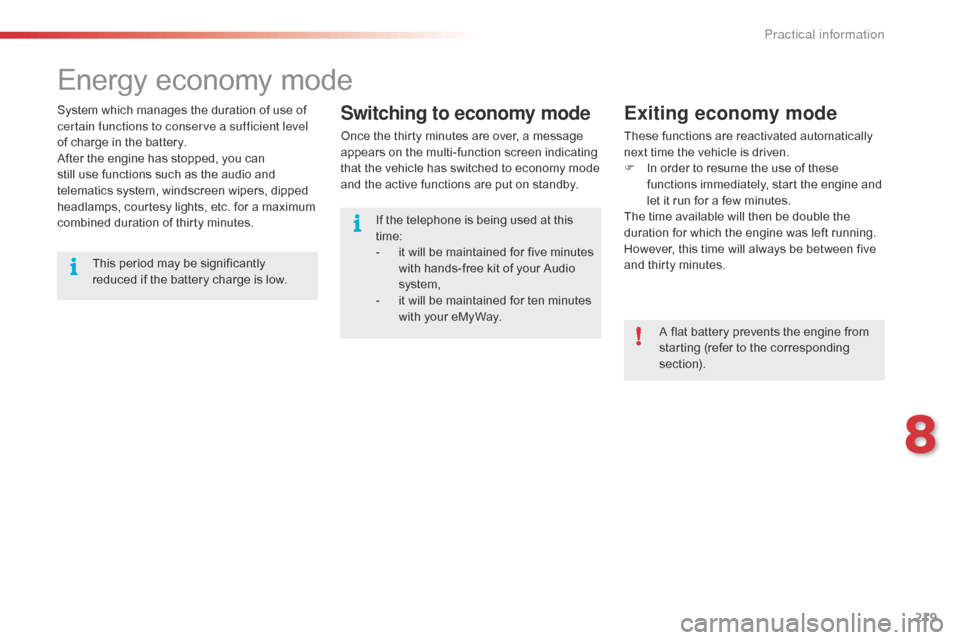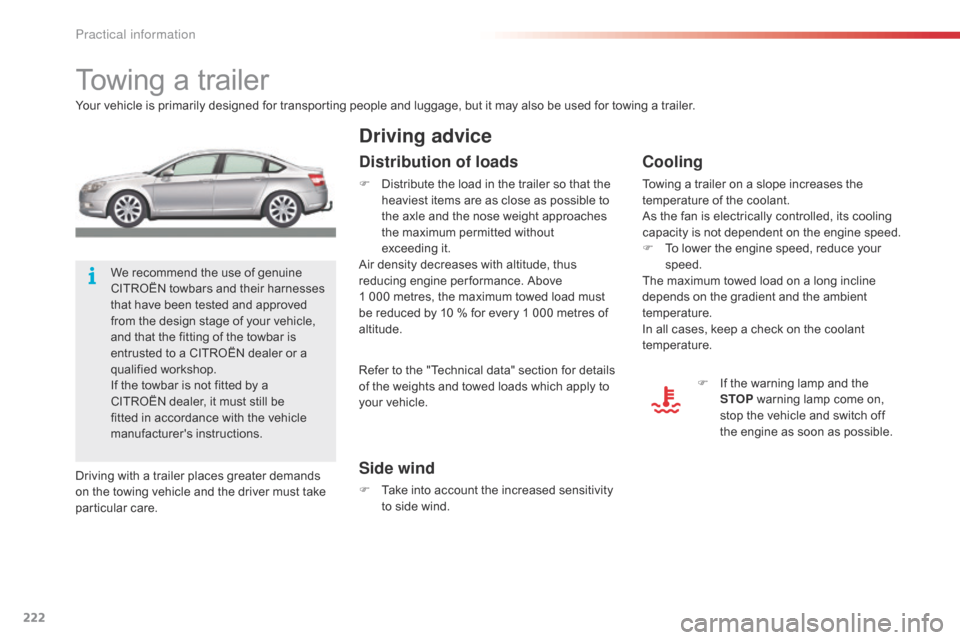Citroen C5 2015 (RD/TD) / 2.G Owner's Manual
Manufacturer: CITROEN, Model Year: 2015, Model line: C5, Model: Citroen C5 2015 (RD/TD) / 2.GPages: 344, PDF Size: 12.95 MB
Page 221 of 344

219
C5_en_Chap08_information_ed01-2014
Energy economy mode
System which manages the duration of use of
certain functions to conserve a sufficient level
of charge in the battery.
After the engine has stopped, you can
still use functions such as the audio and
telematics system, windscreen wipers, dipped
headlamps,
courtesy lights, etc. for a maximum
combined duration of thirty minutes.Exiting economy mode
These functions are reactivated automatically
next time the vehicle is driven.
F
I
n order to resume the use of these
functions immediately, start the engine and
let it run for a few minutes.
The time available will then be double the
duration for which the engine was left running.
However, this time will always be between five
and thirty minutes.
Switching to economy mode
Once the thirty minutes are over, a message
appears on the multi-function screen indicating
that the vehicle has switched to economy mode
and the active functions are put on standby.
A flat battery prevents the engine from
starting (refer to the corresponding
section).
This period may be significantly
reduced if the battery charge is low.
If the telephone is being used at this
time:
-
i
t will be maintained for five minutes
with hands-free kit of your Audio
system,
-
i
t will be maintained for ten minutes
with your eMyWay.
8
Practical information
Page 222 of 344

220
C5_en_Chap08_information_ed01-2014
Towing the vehicle
Access to the tools
The towing eye is installed in the jack box
placed in the spare wheel.
For access to it:
F
o
pen the boot,
F
r
aise the floor,
F
r
emove the towing eye from the jack box.
Procedure for having your vehicle towed or for towing another vehicle using a removable towing eye.
Towing your vehicle
F On the front bumper, unclip the cover by
pressing at the top.
F
S
crew the towing eye in fully.
F
A
ttach a towing arm.
F
S
witch on the hazard warning lamps on the
towed vehicle.
F
P
lace the gear lever in neutral (position N
on the automatic gearbox). Failure to observe this special condition
could result in damage to certain
braking components and the absence
of braking assistance the next time the
engine is started.
In the event of a problem or malfunction
with the electronic gearbox, the vehicle
may be immobilised with a gear
engaged. In this case the front of the
vehicle must be lifted for towing.
Practical information
Page 223 of 344

221
C5_en_Chap08_information_ed01-2014
Towing another vehicle
F On the rear bumper, unclip the cover by pressing:
-
o
n the right (Saloon),
-
a
t the bottom (Tourer).
F
S
crew the towing eye in fully.
F
A
ttach a towing arm.
F
S
witch on the hazard warning lamps on the
towed vehicle. When towing with all four wheels on the
ground, always use a towing arm.
When towing with only two wheels on
the ground, always use professional
lifting equipment.
When towing with the engine off, there
is no longer any braking or steering
assistance.
8
Practical information
Page 224 of 344

222
C5_en_Chap08_information_ed01-2014
Towing a trailer
Your vehicle is primarily designed for transporting people and luggage, but it may also be used for towing a trailer.
Side wind
F Take into account the increased sensitivity to side wind.
Driving advice
Cooling
Towing a trailer on a slope increases the
temperature of the coolant.
As the fan is electrically controlled, its cooling
capacity is not dependent on the engine speed.
F
T
o lower the engine speed, reduce your
speed.
The maximum towed load on a long incline
depends on the gradient and the ambient
temperature.
In all cases, keep a check on the coolant
temperature.
We recommend the use of genuine
CITROËN towbars and their harnesses
that have been tested and approved
from the design stage of your vehicle,
and that the fitting of the towbar is
entrusted to a CITROËN dealer or a
qualified workshop.
If the towbar is not fitted by a
CITROËN dealer, it must still be
fitted in accordance with the vehicle
manufacturer's instructions.
Driving with a trailer places greater demands
on the towing vehicle and the driver must take
particular care.
Distribution of loads
F Distribute the load in the trailer so that the heaviest items are as close as possible to
the axle and the nose weight approaches
the maximum permitted without
exceeding
it.
Air density decreases with altitude, thus
reducing engine per formance. Above
1
000 metres, the maximum towed load must
be reduced by 10
% for every 1 000 metres of
altitude.
Refer to the "Technical data" section for details
of the weights and towed loads which apply to
your vehicle. F
I
f the warning lamp and the
STOP warning lamp come on,
stop the vehicle and switch off
the engine as soon as possible.
Practical information
Page 225 of 344

223
C5_en_Chap08_information_ed01-2014
Blanking cover
When towing, you must remove the blanking
cover in the front bumper as well as the bonnet
seal if fitted.
Contact a CITROËN dealer or a qualified
workshop for this.
Ty r e s
F Check the tyre pressures of the towing vehicle and of the trailer, observing the
recommended pressures.
Lighting
F Check the electrical lighting and signalling on the trailer.
The rear parking sensors will be
deactivated automatically if a genuine
CITROËN towbar is used.
Braking
Towing a trailer increases the braking distance.
To avoid overheating of the brakes on a long
mountain type of descent, the use of engine
braking is recommended.
8
Practical information
Page 226 of 344

224
C5_en_Chap08_information_ed01-2014
Roof bars
The design of your vehicle requires the use
of roof bars that are tested and approved by
CITROËN, for your safety and to avoid damage
to the roof and tailgate.
Regardless of the type of loading equipment
to be transported on the roof (bicycle carrier,
ski carrier...), it is imperative that you add
transverse roof bars. Any securing or lashing to
components other than the roof bars is strictly
prohibited.
Recommendations
F Distribute your load evenly, avoiding overloading on one side.
F
A
rrange the heaviest part of the load as
close as possible to the roof.
F
A
nchor the load securely and draw
attention to it if any part of it is
overhanging.
F
D
rive gently, as the vehicle will be more
liable to the effects of side winds (vehicle
stability may be altered).
F
R
emove the roof bars as soon as they are
no longer needed. Maximum load that can be distributed
on the roof bars (for a loading height
not exceeding 40 cm; except bicycle
carrier): 80 kg.
If the height exceeds 40 cm, adapt your
speed to the profile of the road to avoid
damaging the roof bars and the fixings
on the roof.
Please refer to national legislation in
order to comply with the regulations
concerning the transportation of objects
which are longer than the vehicle.
Practical information
Page 227 of 344

225
C5_en_Chap08_information_ed01-2014
Very cold climate protection*
HDi 160 Diesel engine
Normal position
The flap 2 is in a horizontal position in the air
duct 3.
Snow position
F Push and rotate the knob 1 by 90 ° in the
direction of the arrow in order to position
the flap 2 in a vertical position in the air
duct 3 .
To return to the normal position, push the
knob
1 then rotate in the opposite direction.
It is essential to remove the very cold
protection when:
- the ambient temperature exceeds 10 °C.- driving at speeds of over 75 mph (approximately 120 km/h).
* Depending on country of sale. Adjustable device which prevents the intake of snow particles, which could obstruct the air filter.
8
Practical information
Page 228 of 344

226
C5_en_Chap08_information_ed01-2014
* Depending on country of sale.
Cold climate screen*
Fitting
F Offer up the 2 sections of the snow guard to the upper and lower sections of the front
b u m p e r.
F
P
ress on the surround to clip in one by one
the fixing clips.
Remove
F Using a screwdriver, lever each fixing clip in turn to disengage them.
Before fitting
After fitting Don't forget to remove the very cold
climate screen when:
-
the ambient temperature exceeds 10 °C,- towing,- When driving at speeds of over 75 mph
(approximately 120 km/h).
Removable screen which prevents the accumulation of snow at the radiator cooling fan.
Practical information
Page 229 of 344

227
C5_en_Chap08_information_ed01-2014
Matt paint
If you vehicle is finished with a clear matt
lacquer, please observe the following
recommendations to avoid damaging the
paintwork by the use of an inappropriate
cleaning procedures.
These recommendations are also valid for alloy
road wheels finished with clear matt lacquer.From the range of cleaning and maintenance products in the "TECHNATURE" range recommended
and approved by CITROËN, use only the insect remover and car shampoo, which are the only
products to be used on the bodywork.
The insect remover can also be used to remove minor marks (for example: finger marks...).
Always have paint repairs done by a CITROËN dealer or a qualified workshop.Never clean the vehicle without water.
Never wash your vehicle in an automatic roller brush car wash.
Never polish the vehicle body, nor the alloy wheels. Doing this will make the paintwork
shiny.
Do not use paint cleaners, abrasive products or paint polishing or preserving products (such
as wax, for example) on the paintwork. These products are only suitable for bright finishes.
Application of these products on vehicles with a matt finish will seriously damage the paint
sur face of the vehicle, giving rise to irreversible shiny or stained areas.
Never use a high pressure jet wash with a lance fitted with a brush, this may scratch the
paintwork.
Never select a wash programme that finishes with a hot wax cycle.
We recommend the use of a high pressure jet wash, or at least a water hose with a high
output.
We recommend that the vehicle be rinsed using de-ionised water.
Use only a microfibre cloth to dry the vehicle. It must be clean and used without heavy
pressure.
Lightly wipe off any fuel stains present on the bodywork using a soft cloth, then leave to dry.
Advice on care and maintenance
Recommendations on the care and maintenance your vehicle are given in the maintenance and warranty guide.
8
Practical information
Page 230 of 344

228
C5_en_Chap08_information_ed01-2014
* To avoid any risk of jamming of the pedals:- e nsure that the mat is positioned and
secured correctly,
-
n
ever fit one mat on top of another.
accessories
"Comfort":
front and rear parking sensors, isotherm
module, reading lamp, sun blinds, headrest-
mounted coat hanger...
"Transport solutions":
boot liner, boot carpet, towbars, towbar wiring
harness, transverse roof bars, bicycle carrier,
ski carrier, roof boxes, boot dividers, boot net,
boot organiser, sliding boot tray, platform on
towbar, ...
"Style":
alloy wheels, rear spoiler, chromed mirror
shells, door sill protectors, gear lever knobs...
"Security and safety":
anti-intrusion alarm, warning triangle and
high visibility vest, breathalyzer, first aid kit,
snow chains, non-skid covers, security wheel
bolts, vehicle tracking system, child seats, fire
extinguisher, caravan mirror, pet cage and seat
belt, dog guard...
"Protection":
mats*, seat covers, mud flaps, bumper
protectors, vehicle covers, door and boot sill
protectors...
A wide range of accessories and genuine parts is available from the CITROËN dealer network.
These accessories and parts are all suitable for your vehicle and benefit from CITROËN's recommendation and warranty.
Practical information